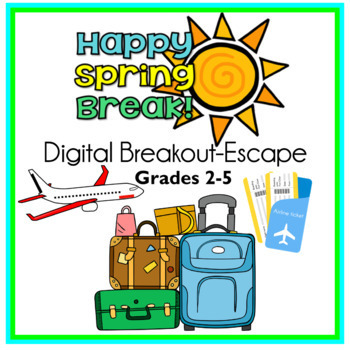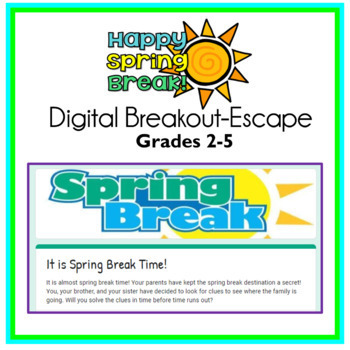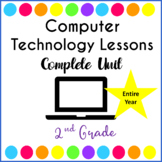Spring Break Digital Breakout Escape Room Grades 2-5
- PDF
- Google Apps™

What educators are saying
Also included in
- An entire year of WEEKLY Computer Technology Lessons & Activities for 2nd Grade. This bundle includes Computer Technology Lessons for Google Drive apps for a WEEKLY Computer Class or for classroom teachers wanting to teach Google Apps on a weekly basis.Each lesson/activity is approximately 30 miPrice $121.32Original Price $127.45Save $6.13
- An entire year of WEEKLY Computer Technology Lessons & Activities for Grades K - 2. This bundle includes Computer Technology Lessons for Google Drive apps for a WEEKLY Computer Class or for classroom teachers wanting to teach Google Apps on a weekly basis.Each lesson/activity is approximately 30Price $312.17Original Price $328.60Save $16.43
Description
NO PREP! 100% Digital - A great way to keep your students engaged before their spring break! This Spring Break Digital Breakout begins as three siblings try to discover where the family is going for spring break. The destination has been kept a secret from the kids. The destination is Disney World! Students will learn a little history about Disney World as well as Disney World costs.
Students are asked to solve the clues to help discover where the family is going before time runs out. Can students solve the clues in time? A fun and interactive way to combine critical thinking, math and reading skills with the excitement of a digital breakout! While working their way through this digital breakout students will encounter clues to help them unlock the breakout.
The Google Form is EDITABLE so you can customize the questions for your students' grade level. Teacher Directions includes tips on making the breakout more and less challenging for some of the clues. The Google Form requires students to solve one clue before moving onto the next.
The breakout can be completed by an individual student, partners, or by a team of students and most students will "breakout" in 30-35 minutes.
The Spring Break Breakout includes the following clues:
Lock 1: Time
Lock 2: Cryptogram
Lock 3: Word Search
Lock 4: Hidden Mystery Message
Lock 5: Reading & Math
Lock 6: Math
Lock 7: Math
DEPENDING ON GRADE LEVEL, NOT ALL STUDENTS WILL BREAKOUT WITHOUT SOME HINTS AND GUIDANCE FROM THE TEACHER.
Spring Break Digital Breakout Includes:
- Link to Google Form Spring Break Digital Breakout
- Teacher Directions & Answer Key







